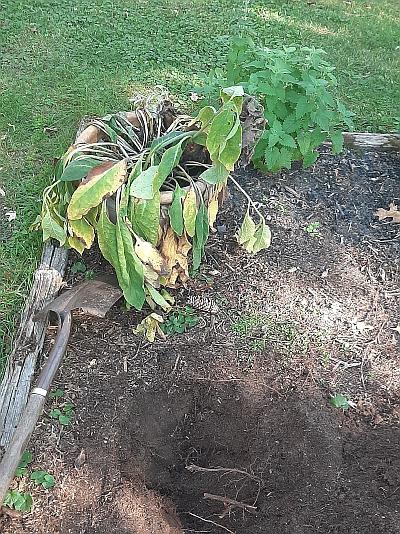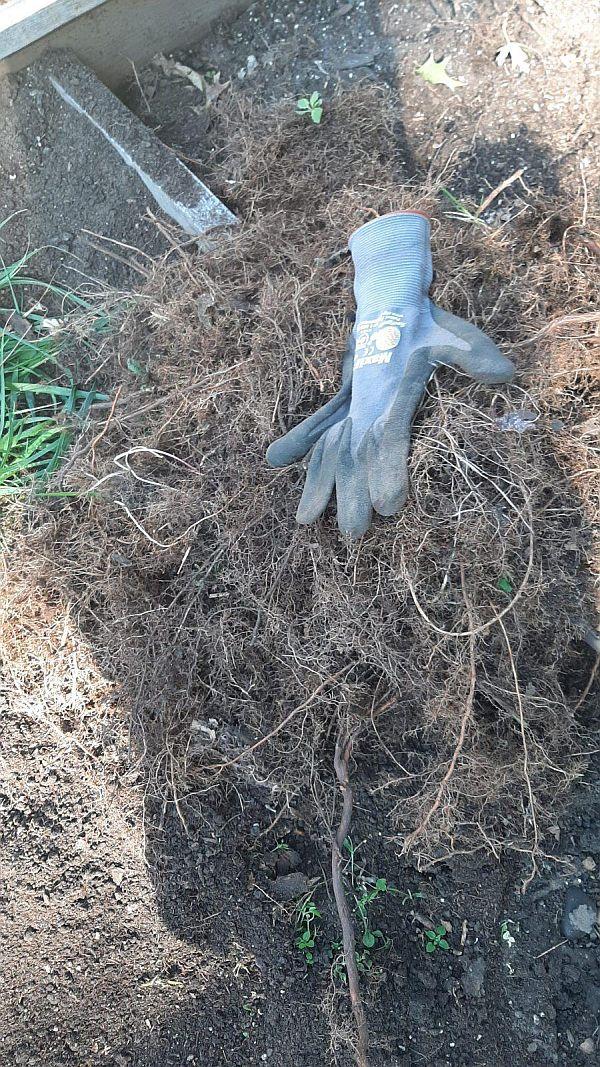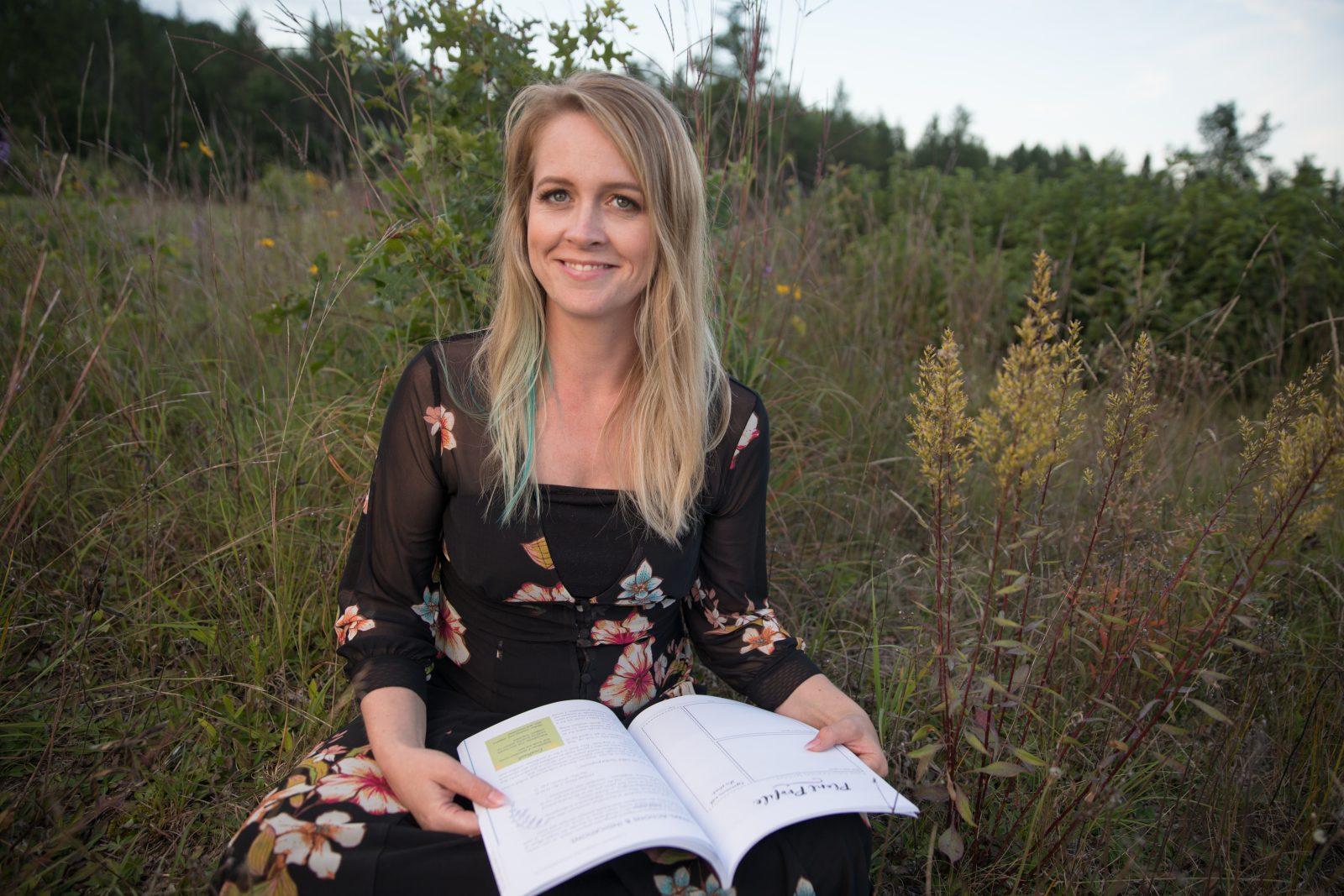My comfrey and echinacea plants are so ready for a nap. Comfrey looks like wilted spaghetti and echinacea looks like a lady after a night at the bar, scorned by a lover, and woke up in a bathroom stall (sorry echinacea, you’re beautiful to me).
Even though they look ragged up top, their roots are MAGNIFICENT!

Comfrey in fall, waiting to be
transplanted from container to the ground

Comfrey in Fall, blooms are spent
My journey to create an herbal, vegetable, and perennial garden is just beginning at our new home. I’ve been blogging about this in my last few posts “Plant as Timekeepers” and
“What I Learned from Not Having a Garden”
My main focus is to get the perennials and herbs I brought from my former home and put them in the ground before the snow flies. Those roots need at least thirty days to start getting established in their new space – unfurling their stifled roots from what must feel like a tomb; digging into the dark soil crevices to seek out sustainable water sources rather than at the whim of human care.
I thought it would be so easy to dig a hole and plop my plants into the ground. Nope. The roots! In some spots I’m digging my shovel into three or more inches of matted roots and under that are feeder roots of the trees in my yard and my neighbors (the oak and maple trees are very tall here so naturally, the roots extend as far as their crowns, or more). Not to mention from past trees that were cut down – those roots are still there!
 Tangle of roots I have to dig through before I get to the soil
Tangle of roots I have to dig through before I get to the soil
 The trees are tall and everywhere in the neighborhood!
The trees are tall and everywhere in the neighborhood!

Three trees in a row in my yard. Makes for a great hammock spot, but not so much for digging in gardens.
On this particular garden day, I purposefully chose to transplant herbs that have medicinal roots – comfrey (Symphytum officinale) and Purple cone flower (Echinacea spp.). And, like I mentioned above, they are looking pretty rugged as they make their journey back to the Earth. All the energy in the leaves, flowers, and stem are descending to coalesce in the roots for protection and to sustain the plant through the winter. Who needs fancy attire when survival is key?
This process of digging in the roots and digging out the roots provided a huge harvest of metaphorical goodness. Here’s a glimpse inside my very own mental conversation:
“How come I have to dig out so many roots in order to put more in? This feels . . . destructive. But, I’m fairly sure these are grass roots which are EVERYWHERE! Like one giant mother grass organism. I’m just giving it a tiny hair cut.
I have to take some roots out to make room for others. In order to put my roots down do I need to remove someone/something else’s? Yikes! that sounds competitive! But, that’s not what I Iearned from reading “The Mother Tree” by Suzanne Simard. Much more cooperation is happening underground than I see above.
With all these roots from standing and felled trees, will I know which of these roots belong to the echinacea when I redig? Will I recognize my roots?”
Will I recognize my roots? MY roots? Am I talking about plants or ME, right now?
Plants are great teachers. Everything in Nature is a teacher with many lessons to show and share. It’s a large fractal repeating itself over and over in different forms.
In terms of the herbs I’m planting, this isn’t the first time other roots intermingled with my herbs. My former garden had the same scenario with herbal roots and other plants tangling together. When I dug comfrey and echinacea I knew Solomon’s seal (Polygonatum biflorum) and tiger lilies (Lilium lancifolium) would be there too. I was very familiar with the plants that grew wild and the ones I was planting and tending to. I watched over the seasons how they changed. I remembered past locations and movements of patches of plants. I knew where past trees were and where to avoid the roots.
At this new home I’m getting to know the roots. I see some familiar ones – tiger lilies are here! Even though I don’t see the aerial parts right now. There’s been years of rock, landscape fabric, and plastic. As I dig, till, and uncover more plants will begin to grow. Ones that haven’t seen the light of sun for years. They will awaken.
I became familiar with roots in the gardens because I took the time to follow unknown roots to the above ground plant organs – stems and leaves. Over and over again I traced the origins of roots to identify stages of growth. Each plant species has distinct attributes like colors, scents, growth habits, textures, shapes, and sizes. That’s how I know some roots from others – observational and experiential learning over and over.
If I harvest roots before the plant is fully formed (which is the way most are harvested in fall or spring) and I have any doubt about the identity, then I have a process. I harvest the roots, dry some, and add to a labeled jar with the location. Then I wait for identifiable characteristics to grow from leaves and flowers. Finally the aerial parts are formed, stand tall, and almost wave “Hi! Yes, it’s me. It’s us! The Comfrey’s. March back into that house, get the jar and label, you were right!”
So, can I trust that I’ll recognize my roots? Of course! I can have confidence in my answer because past experience and the process that I’ve used have served me well.
Part 2 coming next week.
What’s your garden teaching you?
About the author
Erin LaFaive is an herbalist and Plant Priestess with Full Circle Herbals.
“I came about the name Full Circle Herbals because I like all aspects of herbs from growing, harvesting, using, preserving, teaching, and creating.
Some people like growing herbs, others would rather purchase herbs to make remedies and crafts. Some people like teaching about herbs more than growing them. I like all of it! From seed to soil, to body, mind, and spirit.
That’s what you’ll find here ~ teaching, making, growing, seed saving . . . the Full Circle of herbs.







What’s your garden teaching you?
Oof! I don’t know where to begin!
Last year, I moved from one coast to the other. I had a nice garden and beautiful roses that had to be left behind. I was heartbroken to leave the thriving rose bush I planted for my oldest son and the chives my youngest son planted from seeds when he was one.
Where I am now is a beautiful location — BUT there is only space for growing plants is in pots…and those seem to die off quickly. It’s difficult for me to not take it personally! I feel responsible for their loss — and I feel at a loss to understand what my garden is trying to teach me.
Oh my goodness Liz! Leaving behind those plants must have been tough. I hope the next owners enjoy them too. If you’re growing the same plants as you did in the other location, perhaps your garden is trying to teach you to adapt to your new surroundings. That you need to become acquainted with new plant friends. Thank you for sharing your story of your move and garden challenges. Herbal Blessings to you!